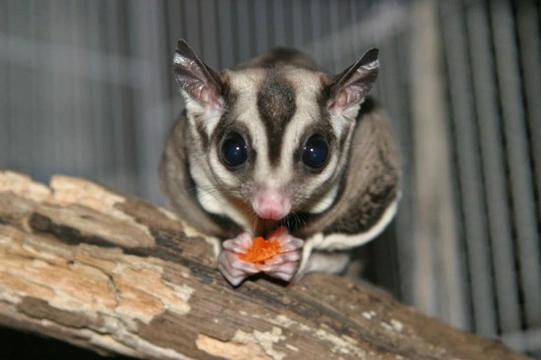
Sugar Gliders: What Are They & Should You Get One as a Pet?
The sugar glider is a small, nocturnal marsupial native to Australia and New Guinea. Known scientifically as a gliding possum, sugar gliders are gaining popularity as exotic pets in the UK, Australia, and the US due to their curious and affectionate nature. However, owning one requires careful consideration of their unique needs and responsibilities. This guide will help you understand what sugar gliders are and whether they could be the right pet for you.
What Exactly Is a Sugar Glider?
A sugar glider is a tiny marsupial characterised by its soft grey fur, distinctive black facial markings, and a flap of skin called the patagium that extends between its wrists and ankles. This membrane allows it to glide gracefully between trees in its natural habitat. The name 'sugar glider' comes from their diet preference; in the wild, they primarily consume sap and nectar from eucalyptus trees, as well as small insects and fruits.
Young sugar gliders spend early life in their mother's pouch, a hallmark of all marsupials. Socially, they live in tight-knit colonies which is key to their wellbeing. As pets, they often bond closely with their human carers but require interaction and companionship to flourish. It’s important to note that sugar gliders are considered exotic pets and their legal status varies by country and region, so you should check local regulations before acquiring one.
What Are They Like as Pets?
Sugar gliders are playful, intelligent, and social creatures. They thrive in pairs or small groups; housing a single glider can lead to loneliness and stress. These animals are nocturnal, meaning they are most active at night and may sleep during the day. Tame sugar gliders accustomed to handling often enjoy cuddling and will bond deeply with their owners.
They require regular human interaction and gentle handling to maintain their social nature. Their claws help them climb and grasp onto owners, which may occasionally lead to nibbling or biting, usually when frightened or startled. Keeping their claws trimmed helps reduce discomfort. With proper care, sugar gliders can live between 12 and 14 years.
What Do They Eat?
Feeding sugar gliders a balanced diet is one of the more challenging aspects of their care due to their specific nutritional needs. Their natural diet includes high-sugar tree sap and protein from insects. Replicating this in captivity involves offering a carefully balanced mix of proteins, fruits, and specialised supplements.
Many experts recommend diets including Leadbetter's Mix (a prepared diet balancing calcium and phosphorus), high-quality insects like crickets or mealworms, and small amounts of fresh, finely chopped fruits. They should be fed in the evening, their natural active time, with care taken to ensure all gliders in a group get enough food. Rapid dietary changes should be avoided to prevent digestive upset. Toxic foods, especially chocolate, must never be given as they can be fatal.
Where Should They Live?
Adequate housing is vital for sugar gliders’ health and happiness. They require a spacious, well-ventilated mesh cage at least 24 inches by 24 inches wide and 36 inches tall, to accommodate climbing and gliding movements. The cage must be secure—sugar gliders are skilled escape artists and can squeeze through very small openings.
Enrichment is critical; provide climbing branches, horizontal bars, exercise wheels, nesting boxes, toys, and a soft marsupial pouch for sleeping. The cage floor should be lined with safe, absorbent substrate like paper-based or wood shavings, avoiding cedar which can be harmful. Clean the cage regularly—at least weekly—to maintain hygiene and prevent illness. Position the cage in a warm, quiet area away from direct sunlight and drafts.
Where Do I Get Sugar Gliders?
For responsible ownership, always acquire sugar gliders from reputable breeders who provide healthy, well-socialised animals. Avoid buying imported or wild-caught gliders, as they endure severe stress and health risks. Reputable breeders offer valuable guidance on care and help ensure your gliders have been raised in a nurturing environment.
You can sometimes find Sugar Gliders for Sale on trusted UK pet marketplaces, advertised by experienced breeders. Purchasing young animals is preferable for easier taming, but if choosing an adult, be prepared for more bonding time and patient handling.
Before introducing sugar gliders to other pets, especially birds or small animals, consider their natural behaviours. Sugar gliders may nip or play with feathers and could be seen as prey by other household pets. Always supervise introductions cautiously to ensure the safety of all animals involved.
Are Sugar Gliders Legal and Suitable for You?
Sugar gliders are exotic pets with specific legal restrictions in some places. In the UK, they are legal to own but may require careful adherence to regulations concerning exotic animals. They are not suitable for everyone, especially not for inexperienced pet owners or families with very young children, due to their specialised care, nocturnal lifestyle, and delicate nature.
Their social needs mean keeping more than one is essential, and owners must commit daily time to interaction and enclosure maintenance. They can make fascinating pets for motivated owners who enjoy the challenge of exotic pet care, but they are far from low maintenance.
Summary: Is a Sugar Glider Right for You?
Owning sugar gliders can be a rewarding experience if you are prepared for the responsibility. These engaging, social animals need proper diet, spacious housing, companionship, and attentive care. They can live over a decade with the right environment and interaction.
If you seek a unique pet and are willing to meet their specialised needs, sugar gliders could be affectionate, playful companions. Always prioritise acquiring from reputable breeders and research thoroughly before bringing them home. Careful planning ensures both you and your gliders enjoy a happy, healthy life.



